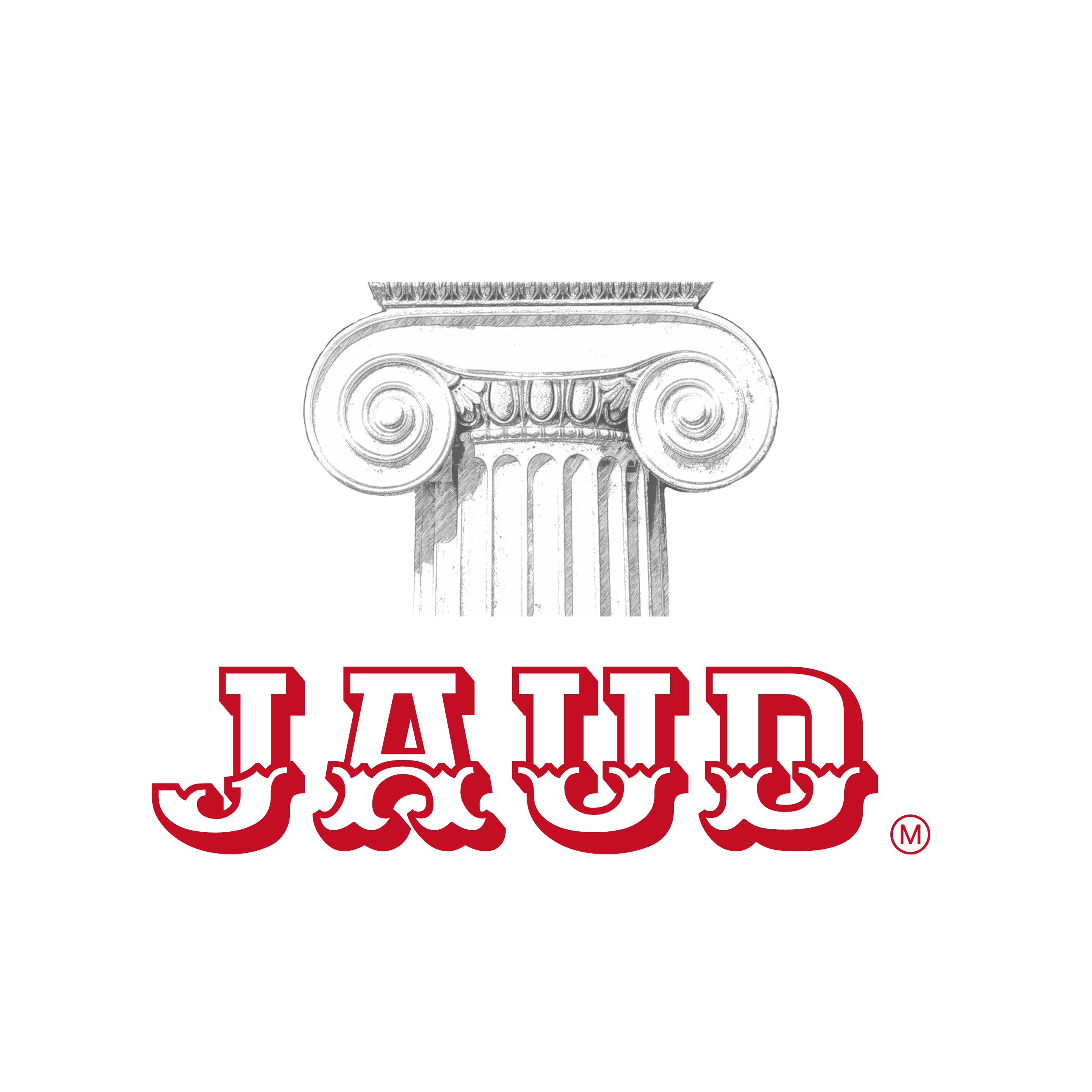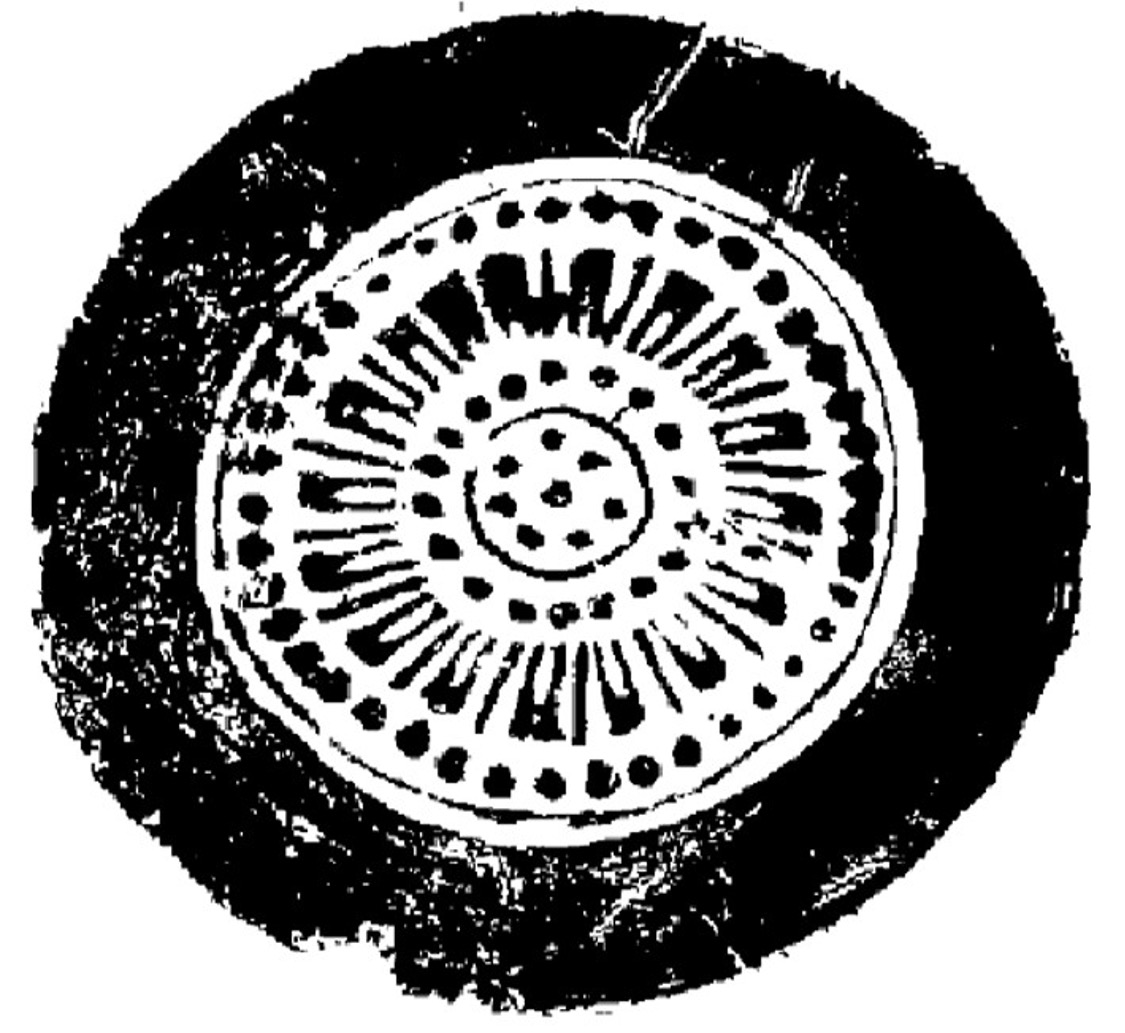In terms of time, the use of a single "bead pattern" tile appeared in the late Tang Dynasty, and researchers believe it evolved from the "lotus pattern" tile. [5] Due to the lack of a unified style for the "bead pattern" tile, it presents a phenomenon of diversification, which also reflects the possibility of differences in architectural styles at that time. Therefore, although there were a large number of tiles with "lotus patterns" during the Sui and Tang dynasties, there were also tiles with "continuous bead patterns" as a single design element, which were no longer used as accessories for the edges of tiles, but independent patterns surrounded by layers of continuous beads. Its characteristic is to have the center of the face to face circle of the tile as.
The core (focal point) radiates outward, providing a strong sense of movement and visual guidance. From the above analysis, it can be seen that the attitude towards Buddhism during the Sui and Tang dynasties was relatively tolerant, which was conducive to the innovation and development of Buddhist art and related decorations. During this period, the phenomenon of Han Dynasty tiles being decorated face-to-face with images or using geometric text was changed, and the basic methods used were as follows:
Lotus, precious flower, animal face pattern, or other floral decoration. There is literature indicating that during the Sui and Tang dynasties, the main trend was the use of the Baoxiang lotus patterned tile (1992 pieces), with less use of ordinary lotus patterned tile (458 pieces) and less use of irregular lotus patterned tile (8 pieces). In the prosperous Tang period, this phenomenon further developed into a new tile style with lotus pods based on the double petal and single petal lotus patterns.
Conclusion
Through the analysis of the roles and roles of the "Lianzhu pattern" in traditional architectural tile decoration art in different periods mentioned above, it can be found that whether it is the symmetrical four part or three part tile that was emphasized in the Qin and Han dynasties, compared with the "lotus pattern" or "treasure phase pattern" tiles with strong Buddhist colors in the Wei, Jin, Southern and Northern dynasties, the former pursued a prayer for eternal life and happiness under the representation of power and will, while the latter shifted to expressing "Lianzhu pattern", "lotus pattern" or "treasure phase pattern" as part of Buddhist art under the rise of Buddhism, which is clearly closely related to the lotus being regarded as a Buddhist holy object.
During the Sui and Tang dynasties, the "Lianzhu pattern", which was paired with the "lotus pattern", rose again with the rise of Buddhist architectural art and became a popular pattern in tile decoration. During this period, not only did the "Lianzhu pattern" appear in large numbers in cities such as Chang'an and Luoyang, but also in tile roofs with "Lianzhu patterns" spread in Korea and even Japan.
In the Song Dynasty and later dynasties, the "continuous bead pattern" gradually moved towards a delicate expression style with the decorative art of tiles, losing the rich and elegant temperament of the Qin, Han, Sui, and Tang dynasties. Even under the influence of the pursuit of "small wooden work" in architectural decoration during the Song Dynasty and beyond, the art of tile decoration and "bead patterns" have completely lost their symbolic and symbolic significance before the Song Dynasty.
From this, it can be seen that tile decoration art is not only a combination of practicality and decoration, but more importantly, it reflects the characteristics of social culture and architectural types in different periods, and even an artistic expression of power and will. The emergence of "Lianzhu pattern" and its various forms of variant styles further enrich the expression and artistic language of traditional architectural decoration art, which is an indispensable part of in-depth research on traditional Chinese architectural decoration.
Table of Contents
- Abstract
- Introduction
The Origins of Lianzhu Pattern and Its Application in Architectural Decoration Art
The main types, styles, and rheological analysis of the "continuous bead pattern" on tiles throughout history
- Conclusion
- Conflicts of Interest
- References
The main types, styles, and rheological analysis of the "continuous bead pattern" on tiles throughout history
1. "Lianzhu Pattern" in the Decorative Art of Tiles in the Qin and Han Dynasties
Qin Wadang mainly uses "cloud patterns" as the main technique, supplemented by "continuous bead patterns". Due to the influence of geometric patterns, the decorative pattern of facing the four quarters was opened in the history of Qin Dynasty tile roofs, providing reference for the design of Han Dynasty tile roofs.
During this period, the "Lianzhu pattern" was generally located in the center of the tile face, and the outer part was usually paired with seal script characters with clear meanings, together forming a suitable circular pattern. The characters in Han Dynasty tiles can highlight the characteristics of architectural types and user identities. For example, tiles with characters such as "Eternal Endless" or "Changle Weiyang" belong to Changle Palace and Weiyang Palace, reflecting the auspicious meaning bestowed by the builders of Han Dynasty palaces through decorative techniques, in order to pray for happiness and health. Another type is the combination of "cloud patterns" and "continuous bead patterns" on tiles, which have neither written nor other animal patterns with special symbolic meanings in front of them. Among the series of cloud patterned tiles unearthed from the B area of the Guigong No. 2 architectural site in Chang'an City, Han Dynasty, the "continuous bead pattern" is located in the center of the face, surrounding the central raised center, and the outer side is a common cloud pattern found in Han tiles. However, this arrangement of "bead patterns" is somewhat similar to the lotus shaped design, and also implies the metaphor and symbolism of the two in early tile decoration. [2]
However, the "Lianzhu pattern" of the Han Dynasty was not found in animal patterned tiles, such as the symbolic "Four Gods" of Qinglong, Zhuque, Baihu, and Xuanwu, and ordinary tiles decorated with images of cows, horses, and deer.
From the patterns of cloud patterned tiles unearthed from the Guigong No. 2 Site in Chang'an City, it can be seen that all unearthed artifacts belong to the middle and late period of the Western Han Dynasty, indicating that cloud patterned (especially sheep horn shaped cloud patterned) tiles were already quite common during this period, and can even be divided into various subtypes such as "continuous bead pattern" or "grid pattern". [3]
It is worth mentioning that although the decorative styles of the Han Dynasty's "Lianzhu Wen" tile were relatively diverse, the items decorated with "Lianzhu Wen" during this period were not all circular, but also square or other shapes. The appearance of "continuous bead patterns" in decorative patterns such as building wall tiles or floor tiles indicates that "continuous bead patterns" are not limited to circular tiles in traditional architecture, but are also used for decorative components for other purposes.
The prosperity of the Han Dynasty's tile decoration, especially the richness of the Western Han Dynasty's tile decoration art, can be attributed to more than half a century of recuperation and long-term accumulation in building culture and economic strength at that time. In terms of palace architecture, the Western Han Dynasty also demonstrated a more magnificent and magnificent atmosphere than the Qin palace architecture, with large architectural complexes such as Changle Palace, Weiyang Palace, and Guigong.
The "continuous bead pattern" on the tiles of the Han Dynasty is generally used in combination with textual patterns, animal patterns, and floral patterns. Therefore, the main categories that often match "bead patterns" are as follows: 1 The auspicious text pattern used to express intentions; 2. Combine with floral patterns to form a suitable circular pattern; 3. A pattern that forms a quarter or three pattern with geometric cloud patterns.
3. "Lianzhu Pattern" in Decorative Art during the Sui and Tang Dynasties
During the Sui and Tang dynasties, the progress in architectural scale and technology was fully reflected in the construction of the Sui Daxing and Tang Chang'an cities. Not only was the urban planning and layout well-organized, more reasonable than the previous dynasties, but also more exquisite in the expression techniques and styles of decorative art. Luoyang, the eastern capital, became the main city where tile decoration art was more prevalent, and the short history of the Sui Dynasty was not limited.
The widespread application of "bead pattern" as an essential element in tile decoration. The "bead pattern" and "lotus pattern" in tile decoration continue to match the paradigm of the Wei, Jin, Southern and Northern Dynasties period, and are more popular in palace or temple architecture.
From a morphological perspective, the Sui Dynasty tiles were generally decorated with "lotus patterns", and had the characteristic of a wider edge wheel and a relatively smaller middle decorative part. The tiles with continuous bead patterns in the Tang Dynasty basically continued the tile style influenced by Buddhism in the Northern and Southern Dynasties. However, except for the Buddha statue in the center of the tile, the pattern was more concise and dignified.
Lotus patterned tiles are also popular in remote areas. Not only have a large number of lotus patterned tiles been unearthed from architectural sites such as palaces, government offices, cemeteries, and temples, but also a considerable number of lotus patterned tiles have been unearthed from residential and residential sites [5] The "continuous bead pattern" in the tiles during the 347 period is relatively full and round, which, when paired with the "lotus pattern," highlights the high relief effect in front of them. According to analysis, the "lotus pattern" basically adopts a triple combination of relief patterns, with the outer part being the accessory part, the middle part being the lotus petal part, and the core part being the protruding lotus pod shape. Although the size specifications of the three parts of the "lotus pattern" tile during this period were different, and there were even single and double petals on the lotus petals, the triple combination style formed a basic paradigm that was more commonly seen in the Tang Dynasty tile pattern
From the changes in the position and pattern characteristics of "continuous bead patterns" in the decoration of tiles during the Sui and Tang dynasties, tiles with "continuous bead patterns" during this period can be mainly divided into the following five different types: 1 The type of edge decoration on the outer edge of the "lotus pattern" in person; 2. In the center of the face, the shape is similar to a lotus seed; 3. Two or more concentric circles appear simultaneously at the outer edge and center of the face; 4. The type of edge decoration on the outer edge of the "beast face pattern" in person; 5. Face to face decoration language is mainly based on "bead patterns". Of course, some researchers have also distinguished the types of patterns based on the singular and plural forms of the "lotus pattern" petals, focusing their perspectives mainly on the changes and comparisons of the "lotus pattern", which intersects with the decoration of the "continuous bead pattern". If there were previous researchers who classified the tile patterns of this period into five different types, it was based on the above methods for identification. [2]
In addition, there are also a few Tang Dynasty tiles where the "continuous bead pattern" is unified with the lotus shaped core, forming a clever design that can be seen as a lotus shaped shape and also conforms to the "continuous bead pattern" form. This type of tile combines lotus pods and "continuous bead patterns", with six, seven, and eight beads in the core part being the most common in terms of quantity (Figure 1).
The main types, styles, and rheological analysis of the "continuous bead pattern" on tiles throughout history
Wadang is the physical basis for understanding traditional architectural forms, techniques, and materials throughout history. In various periods of tile decoration patterns, although "bead pattern" is often used as an accessory part of the tile, the role and significance of this pattern cannot be ignored. Especially during the flourishing period of Buddhist art in the Wei, Jin, Southern and Northern Dynasties, "bead patterns" appeared extensively in tiles and had special meanings and directions.
Comparing the tiles with "continuous bead patterns" from different periods, it can be found that whether it is the tile decoration with characters and animal shapes in the Han Dynasty or the plant and flower patterns as the main expression content in the Sui and Tang Dynasties, various subtypes of patterns that are matched with "continuous bead patterns" have emerged. The characteristics of these subtypes are that although they are not primarily composed of "continuous bead patterns", they cannot be separated from the contrast and modification of "continuous bead patterns". From the content expressed by tiles with "continuous bead patterns" throughout history, it can be seen that "continuous bead patterns" are mainly used as decorative elements.
4. "Lianzhu Pattern" in Decorative Art during the Northern Song Dynasty
During the Northern Song Dynasty, the theme of tile decoration changed again, with realistic animal patterns as the main content. This theme of tiles continued until the late Northern Song Dynasty. During this period, although the characters of the "Lianzhu pattern" did not change, their expressive techniques clearly tended to be simpler, and there were no longer the rich expressive techniques and styles of flower and grass patterns in the Sui and Tang dynasties. The reason for this is related to the pursuit of realistic expression in the Northern Song Dynasty, which weakened the "bead pattern" decoration. This also indicates that the role of "bead patterns" in traditional architectural decoration is gradually fading.
In the "Lotus Pattern" tile decoration unearthed at the Northern Song Dynasty Imperial Tomb Site in Gongxian County, Henan Province, it can be understood that although the content of the decorative patterns during this period has not decreased, the edge wheels on the face have widened, and the petals of the "Lotus Pattern" have significantly decreased. Even fundamentally changed the form of lotus and precious flowers, becoming flower patterns with small petals and a large number, changing the full, generous, dignified and beautiful form of flower patterns in the Sui and Tang dynasties. This phenomenon also affected the tile decoration style of the Liao, Jin, and Yuan dynasties. For example, in the tile decorations unearthed at the Dabaotai Jin dynasty site in Beijing and the Yuan dynasty site in Houyingfang, which were mainly based on plant and flower patterns, both had the characteristic of pursuing intricate and gorgeous patterns in the Song dynasty tile decoration.
The "continuous bead pattern" in the decoration of Song Dynasty tiles should have been commonly used in buildings such as palaces, Taoist temples, and temples. Not only did there be no significant difference in the materials, shapes, and decorative characteristics of the tiles, but they were mainly composed of plant and flower patterns. From the eaves tiles unearthed at Jianfu Palace Site in Qingcheng Mountain, Sichuan Province, and East Tower Site in Guoning Temple, Ningbo, Zhejiang Province, the patterns of plants and flowers in the Song Dynasty have expanded to new categories such as chrysanthemums and peonies.
Another characteristic of tile decoration in the Northern Song Dynasty is the appearance of "dragon patterns" and their combination with "continuous bead patterns". From a holistic perspective, these two different elements form a stylistically uncoordinated relationship. This pattern is different from the dragon pattern in the decoration of the Han Dynasty tiles: the Han Dynasty dragon pattern was a patterned decorative symbol, while the dragon pattern in the Northern Song Dynasty tiles tended to be more realistic, and the description of details was more in-depth and delicate. Specifically, it can be distinguished from the dragon pattern dripping water unearthed from the Baichengzi ancient city site in Zhangbei, Hebei, and the tile patterns unearthed from Yongzhao Mausoleum in Gong County, Henan and other places. [2]
During the Yuan and Ming dynasties after the Song Dynasty, the "continuous bead pattern" gradually declined in the tiles. There are no other decorative techniques used on the outer edge of the tile, but rather it is left vacant or replaced by edged patterns. This indicates a change in the decorative art style of tile tiles since the Han Dynasty, or a decline in recognition and love for the "continuous bead pattern" style. It also indicates that after the Song Dynasty, the "continuous bead pattern" no longer had the Buddhist color of the Northern Wei and Sui and Tang dynasties, and only existed as an artistic expression in the decoration of other objects.
© 2024 by the authors. Published by Michelangelo-scholar Publish Ltd.
This article is published under the Creative Commons Attribution-NonCommercial-NoDerivs 4.0 International (CC BY-NC-ND, version 4.0) license (https://creativecommons.org/licenses/by-nc-nd/4.0/), which permits non-commercial use, distribution, and reproduction in any medium, provided the original work is properly cited and not modified in any way.
Article Metrics
Waiting for update.
Share and Cite
Chicago/Turabian Style
Liang Zhu, "A Study on the "Lianzhu Pattern" and Its Evolution in Traditional Chinese Architectural Tile Decoration." JAUD 1, no.1 (2024): 49-65.
AMA Style
Liang Zhu. A Study on the "Lianzhu Pattern" and Its Evolution in Traditional Chinese Architectural Tile Decoration. JAUD. 2024; 1(1): 49-65.
Introduction
Wadang was originally a component used to shield the front end of the tube tiles on the eaves of traditional Chinese architecture. It was originally designed to prevent rainwater erosion and protect the eaves. As early as the Qin and Han dynasties, there was already a clear concept of hierarchy in terms of architectural volume, decorative styles, and techniques. As one of the traditional architectural components, the exploration of the content and form of the tile has laid a solid foundation for the traditional decorative art style of China since the Qin and Han dynasties. Especially, some patterns with symbolic meanings in the tiles of the two Han dynasties have become symbols of traditional Chinese cultural identity. Among them, some commonly used patterns have distinct historical characteristics and artistic value in traditional Chinese architecture, and "Lianzhu pattern" has such characteristics and influence in traditional architectural tile decoration due to its simple beauty.
Existing research, including archaeological excavation reports, mainly explores the basic style, form, and configuration relationship of "Lianzhu pattern" in traditional architectural tiles and other artifacts, but pays less attention to the role and rheological characteristics played by traditional architectural decorative art throughout history. This article takes the "bead pattern" in traditional Chinese architectural tile decoration art as the research context, attempting to further understand the basic decorative language and symbolism of traditional architectural art through the analysis and comparison of the characteristics and changes of tile decoration in different periods, in order to promote in-depth research and understanding of the construction ideas and formal language of traditional architectural art in various major historical stages.
The Origins of Lianzhu Pattern and Its Application in Architectural Decoration Art
As a traditional decorative pattern, "bead pattern", also known as "bead pattern", is a decorative pattern composed of multiple consecutive beads or circles of the same size, used as a circular or other shape (mainly seen on circular objects). This pattern has the characteristics of stable structure, complete morphology, and a combination of motion and stillness. "Lianzhu pattern" is commonly seen in the decoration of early bronze ware, fabrics, and architectural tiles. In terms of arrangement, "bead patterns" generally form a combination of circular, straight, and square shapes. Although the "Lianzhu pattern" is simple in composition and often used in conjunction with other decorative patterns, it does not affect its popularity and dissemination as a symbol of completeness and auspiciousness in decorative art throughout history.
Previous studies have suggested that the "Lianzhu pattern" is a pattern derived from Persian decorative art in the Western Regions (now found in the ancient tomb of Astana in Turpan). Because this style was once a popular style during the Sassanid dynasty in Persia. During the Sassanid dynasty, the "bead pattern" was also symbolized as the sun and was often used in the decoration of "bird bearing" and "bird facing" or "horse facing" shapes, with rich religious story connotations.
In the decorative arts after the Qin and Han dynasties, the "continuous bead pattern" was widely used, reflecting the combination of foreign forms and traditional Chinese aesthetics. In fact, the "Lianzhu pattern" is still widely used in ethnic minority folk decorative art in Xinjiang, but this does not hinder the study of the role and evolution of this pattern in traditional architectural tile decoration from the perspective of local decorative elements. Various phenomena indicate that "Lianzhu pattern" may not be a decorative pattern that emerged in a certain region, but has a background and characteristics of multiple ethnic groups and regions.
But from the outer edge of the back of the late Shang Dynasty leaf vein pattern mirror unearthed from the Fuhao Tomb in Xiaotun, Anyang, Henan, it can be seen that the periphery is decorated with continuous bead patterns. [1] In addition, the neck of the late Xia Dynasty Lianzhu patterned bronze vessels unearthed in Xinzheng, Henan Province, also features Lianzhu patterns. This indicates that the continuous bead pattern was already applied in the decoration of practical tools in daily life during the Shang Dynasty, indicating that this pattern should belong to a decorative element commonly used by different ethnic groups or regions.
In addition to tiles, the Tang Dynasty's brocade decorated with "continuous bead patterns" was also known as continuous bead pattern brocade; Meanwhile, the "bead pattern" is also a common decorative pattern in Buddhist architecture (grotto temples). The murals in the Dunhuang Grottoes from the Wei, Jin, Southern and Northern Dynasties to the Sui and Tang Dynasties all have "continuous bead patterns" painted on them. In the murals of Cave 420 (Sui Dynasty) in Dunhuang Grottoes, both the flying horse and training tiger are depicted with "continuous bead patterns" on the circular edges. In addition, on the painted robe of the 427th cave Buddha statue, which is also from the Sui Dynasty, there is also a plump "bead pattern" painted on it. The above phenomenon shows that the "Lianzhu pattern" has been continuously appearing in the field of decorative art related to Buddhist architecture during the spread of Buddhism and Buddhist decorative art through the Western Regions to the Central Plains, becoming another main path for the spread of "Lianzhu pattern".
2. "Lianzhu Pattern" in Decorative Art during the Wei, Jin, Southern and Northern Dynasties
One of the reasons why "Lianzhu pattern" was widely used and valued in the decoration of architectural tiles during the Wei, Jin, Southern and Northern Dynasties period was due to the rise of Buddhist art and the high demand for related themes in a large number of temple buildings. This can also be seen as an important stage in the development of "bead patterns" in traditional architectural decoration. It can even be considered that the "Lianzhu pattern" meets the dual needs of religion and architecture in form, and reflects the exploration of new forms in architectural decoration art under the influence of foreign art at that time (such as replacing lotus or other animal and plant patterns in Han Dynasty tiles with Buddha statues). Even during this period, "bead patterns" appeared in some mural decorations of grotto temples.
Unlike the Han Dynasty, the material of the tiles during this period was generally mud gray pottery, with "bead patterns" and "lotus patterns" becoming a relatively fixed combination. According to literature analysis from a typological perspective, it is believed that the tile style during the Wei, Jin, Southern and Northern Dynasties period, apart from the changes in lotus petals from double petals to single petals and in terms of size and scale, had similar or similar design elements. The differences between tile styles in different periods were relatively small. If compared horizontally, the Yunzhong Ancient City in Inner Mongolia, Datong in Shanxi, and the Northern Wei Site in Luoyang, Henan all have Buddha statues and tiles decorated with "bead patterns", with "hands clasped together in ten". They basically belong to the same type. [4]
From the unearthed areas of the above-mentioned tile styles, it can be seen that the "lotus pattern" tiles unearthed at the Zhumingmen site in the southern city of Ye, Linzhang, Hebei, as well as at the sites of the vi and viii platforms in the northern city of Ye, all have "connected pearl patterns" as accessories.
However, some of the "bead patterns" in the Northern Wei tiles are semi circles highlighted in relief, while others are hollow circles. In addition to the circular shape of the tiles facing each other, some tiles have a "bead like pattern" that closely resembles the shape of lotus petals, making it difficult to distinguish between the patterns.
Abstract
The "continuous bead pattern" in traditional Chinese architectural tile decoration reflects the differences in construction culture and aesthetic pursuit through the formal language and directionality presented throughout history. From the early Western Han Dynasty geometric pattern tiles to the beast faced tiles of the Northern Song Dynasty, the types and styles of "continuous bead patterns" have been continuously expanded and refined with the development of traditional architecture. Through the research and analysis of the early origins of the "Lianzhu pattern", a systematic evaluation was given on the role and function of this pattern in the decoration of architectural tiles in various periods. The article points out that "bead pattern" is not simply a decorative or auxiliary pattern, but is widely used as a symbol with specific symbolic significance and value. It is believed that it is precisely because the "bead pattern" has a special symbolic meaning of auspiciousness that this pattern is recognized and accepted as an indispensable element in tile decoration throughout history.
School of Art and Design, Tianjin Tianshi College, Tianjin, China
* Author to whom correspondence should be addressed.
JAUD. 2024, 1(1), 49-65; https://doi.org/10.59528/
Received: April 5, 2023 | Accepted: June 12, 2023 | Published: June 26, 2023
Liang Zhu*
by
A Study on the "Lianzhu Pattern" and Its Evolution in Traditional Chinese Architectural Tile Decoration
References
1. Wang Yu Exploring the Meaning of Copper Mirrors Excavated from the Fu Hao Tomb in Yin Ruins Central Plains Cultural Relics, 2014, (2)
2. Shen Yunyan Research on Ancient Chinese Tiles [M] Beijing: Cultural Relics Publishing House, 2006
3. Sino Japanese Joint Archaeological Team (Institute of Archaeology, Chinese Academy of Social Sciences, Nara National Institute of Cultural Property, Japan) Excavation report on the third building site of Guigong in Chang'an City, Han Dynasty [J] Archaeology, 2001, (1)
4. Wang Xiuling. World of Cultural Relics, 2009, (2)
5. Chen Liangwei A typological study on the unearthed tiles from the Sui, Tang, and Northern Song dynasties in Luoyang Archaeological Journal, 2003, (3)
Conflicts of Interest
The author has no conflicts of interest with respect to the research, authorship, or publication of this article.




